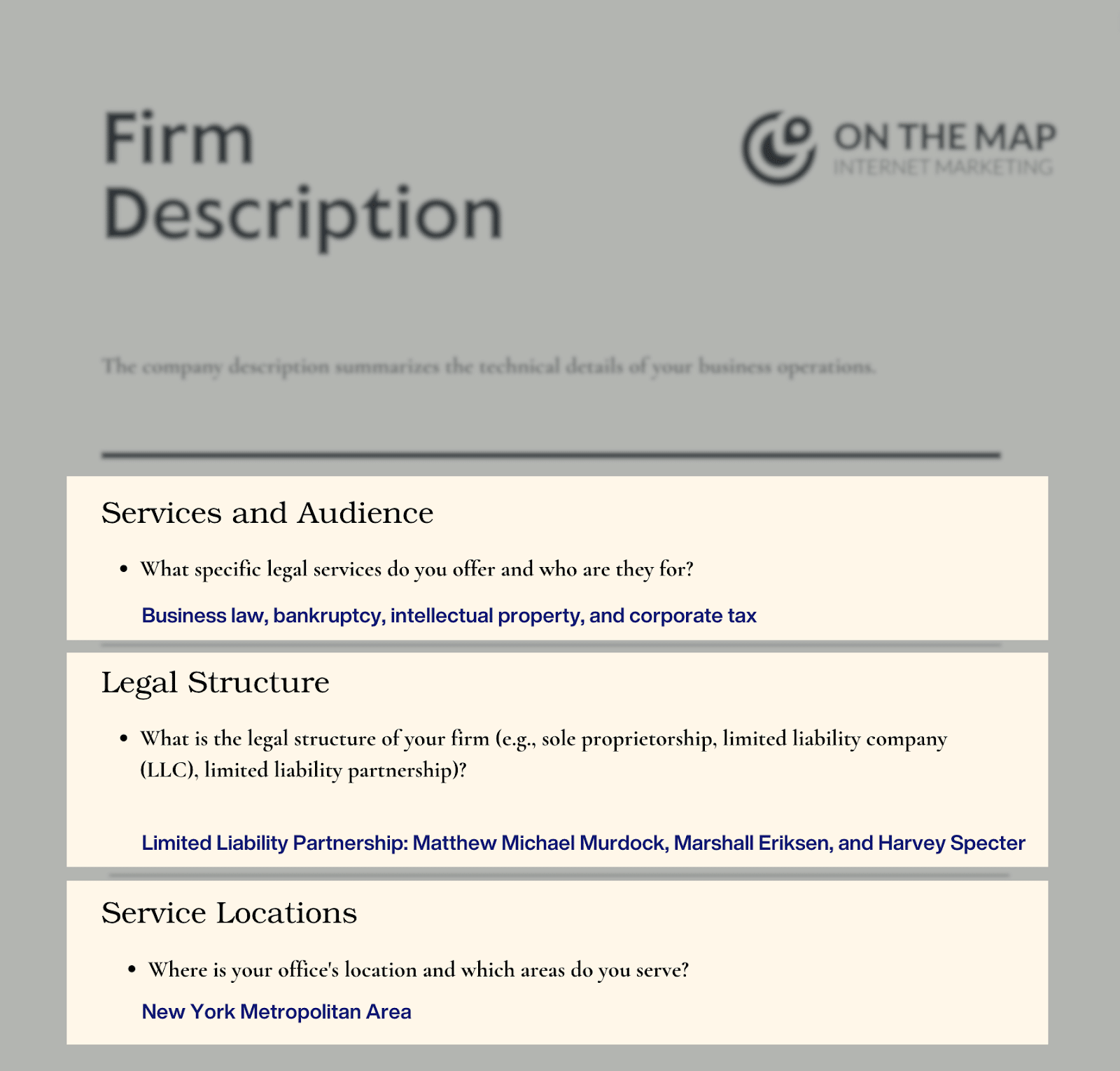How to Create a Law Firm Business Plan
What is in a Law Firm Business Plan?
A law firm business plan is an essential piece of document that outlines the goals and growth strategies of your venture.
Ideally, your plan contains several components, such as an executive summary, company description, marketing strategy, financial plan, and organizational structure to streamline law office management.
Why Your Law Firm Needs a Business Plan
Here are some of the biggest reasons why you need a law firm business plan:
- Establish your position in the market with unique value propositions.
- Set realistic goals to drive your marketing and business development forward.
- Better manage your law firm by guiding your decision-making process.
- Define an organizational structure for effective communication and collaboration workflows.
- Make better hiring decisions to keep your workforce as lean and efficient as possible.
- Ensure your capital is invested and allocated wisely.
- Create a profitable business model moving into the future.
Things to Consider Before Creating Your Business Plan
As a law firm, your business plan lays the foundation for a financially and professionally successful firm. It’s not something that you can go back to and revise whenever you want.
So, before creating your business plan, settle down and gather your thoughts on how you envision your firm’s success.
More specifically, you need to deliberate on your law firm’s goals, fee structure, and revenue targets.
Define Your Goals
How would you define success as far as running a law firm goes? What are the positive values you want to live by, and how will they benefit your future clients?
A well-defined goal may not seem as important initially, but it significantly impacts your decision-making as you flesh out your business plan.
Your goals can affect how you hire your staff, build your law firm website, plan your pricing, decide whether or not to hire a law firm marketing agency, and so on. They will also help you plot out short- to mid-term goals, which serve as milestones that bring you closer to your long-term goals.
Some examples are:
- To have acquired 200 clients by the end of the first year in business.
- Build a solid law firm brand and grow online traffic by 200% in the first six months.
- Attain a case closure rate of at least 80% by the beginning of the third quarter.
Build Your Firm’s Fee Structure
Building your fee structure is an important step that also helps determine if your specified short-term objectives are realistic.
It’s generally a good idea to look at how competitors charge clients for their services. This should give you a baseline rate for similar services you offer.
You can also adopt policies like “no fee unless you win” over an hourly rate, which can attract clients by transferring risk to the firm.

Set Your Revenue Targets
Your annual revenue target is the last measurable piece of information you need to pin down before preparing your law firm business plan.
Don’t be afraid to aim high and exceed the average annual salary of attorneys in your law practice area. Keep in mind that, on top of essential expenses like student loan payments, office lease, insurance, and mortgages, you’ll need more funds for marketing your law firm and growing your team.
To put things into perspective, 2024 data from PayScale revealed that the average annual salary of lawyers in the United States is $97,720.

You can use the average salary as your baseline and increase your target revenue based on how much you’re willing to spend on marketing, advertising, and hiring.
Factor in your fee structure to determine how many clients you need. Of course, you should also consider the number of founding lawyers that your firm starts with.
Finally, use your own discretion and only lower the bar if you believe your target revenue is not humanly possible in terms of caseload. For example, if your target revenue requires you to handle over 150 active cases a month (which most lawyers would still consider attainable — depending on their practice area), you may need to readjust your expectations.

8-Point Law Firm Business Plan Checklist
Now that you have nailed your goals, fee structure, and target revenue, it’s time for the nitty-gritty of building a law firm business plan.
Here’s a rundown of all the key details you must include:
1. Executive Summary

The executive summary provides a concise, top-level overview of all the other elements of your business plan. It also encapsulates three points that give your law firm its unique identity, namely:
- Mission statement: A mission statement focuses on your firm’s purpose and guiding principles, including your commitment to new clients. It should ideally be two sentences at most.
- Core values: Your core values should reflect what you stand for as a legal professional — guiding your firm through tough decisions and challenging cases. Looking for employees who resonate with your core values also helps build a more productive, collaborative, and tightly-wound workplace culture.
- Unique value/selling proposition: A Unique Selling Proposition (USP) is a more direct statement that answers the question, “Why should clients pick you?” Try to capture the benefits and unique qualities that make your firm stand out.
2. Company Description

Next up, the company description summarizes the technical details of your business operations. This provides partners and potential investors a general idea of what your firm does on a day-to-day basis.
Below are the aspects that your firm description should cover:
- Services and target audience: What specific legal services do you offer, and who are they for?
- Legal structure: What is the legal structure of your firm (e.g., sole proprietorship, limited liability company (LLC), limited liability partnership)? If you’re forming a partnership, be sure to include the names and practice areas of each partner. If you are registering an LLC, it’s essential to understand how regulations vary by state to optimize your setup and ensure a smooth registration process. For example, forming an LLC in California involves higher fees and specific annual requirements, while New York requires the publication of your LLC formation in local newspapers, adding to the cost and complexity.
- Service locations: Where is your office’s location, and which areas do you serve?
3. Market Analysis

Every business plan — regardless of industry — needs preemptive market research to set initial financial projections on revenue and marketing performance.
Dig deep to gauge the demand for your services, how your target audience makes hiring decisions, who your competitors are, and your potential clients’ spending power. Your local bar association website should be a great place to start, along with local attorney directories and legal industry reports.
Be sure your line of inquiries encompasses the following details:
- Your ideal client: Who are you marketing your law firm to? Fill this information with demographic data, such as age, gender, occupation, and location.
- Client motivations: Why do prospects need your legal services? List down their pain points and the qualities they’re looking for in a law firm.
- Industry description: What is the projected size of your market? Are there any ongoing trends to consider?
- Competitive analysis: Build a list of known competitors in your area (similar practice areas serving the same location). You may also include indirect competitors that also compete for your target audience’s attention.
- Projections: How much are your ideal clients willing to pay for legal services? This will help you make fine adjustments to your fee structure.
4. Organization and Management Structure

The next section of your law firm business plan expands on the details of your partners and core staff members.
This process is as straightforward as it gets. Just write up their names, law school, experience, and primary roles in your new firm.
For bigger firms, you may need to create an organizational chart that visualizes who each member reports to.
5. Legal Services

After filling out the organization and management section, create summaries of the legal services your firm will provide.
For example, if you run a business law firm, are you going to cater to dispute resolution, intellectual property, contracts, estate planning, or corporate tax clients?
What specific problems do these services solve? What is your flat fee per hour or case?
More importantly, what are your firm’s unique advantages over competitors that offer similar services?
6. Marketing Strategy

Next comes the more challenging aspects of drawing up a law firm business plan.
In the marketing plan or strategy section, you need to determine a handful of details that play a critical role in your firm’s growth. This includes:
- Target client persona: Briefly describe the profile of your target market (as defined in your market analysis). Then, identify their media consumption preferences, like social media, magazines, and search engines.
- Marketing goals: Map out the marketing objectives you wish to accomplish within set timeframes. For example, are you looking to generate a specific number of leads through online marketing or securing more referral leads from local business partnerships?
- Key Performance Indicators (KPIs): Which KPIs will you use to measure law firm marketing success? You can set target values and brackets to rate the performance of your strategies (getting 10+ clients a month can be rated as excellent, whereas getting less than three clients can be rated as very poor).
- Strengths, Weaknesses, Opportunities, and Threats (SWOT) analysis: An in-depth SWOT analysis can help you set campaign-level objectives for your marketing efforts. For example, having a lot of perfect, five-star reviews on your Google Business Profile is a strength you can leverage to boost your brand image.
- Marketing platforms: What content creation and distribution channels will you use to market your law firm? Depending on your answer, which tools and services do you need to make the most out of your channels?
- Marketing budget: Finally, you need to cook up a detailed law firm marketing budget. Itemize the platforms and strategies you want to use and allocate a budget accordingly (e.g., $3,000 for SEO, $4,000 for billboards, and $2,000 for PPC advertising).
7. Financial Plan

A solid financial plan does two things: ensure your firm doesn’t run out of cash and create a positive profit margin needed for growth.
Since you’re still building your business plan, you only need to focus on your first year.
Here are the items you need to include:
- Monthly expenses: In addition to your marketing budget, you need to take into account other expenses. Some examples are office space, utilities, IT support, and salaries.
- Monthly target revenue (up to 12 months): Based on the fee structure and revenue goals you calculated earlier, determine the monthly revenue you need to be on track. This should be well above your firm’s monthly expenses.
- Cash flow statement: Attach a cash flow statement to the financial plan section of your law firm business plan. Update your revenue, expenses, and budget accordingly throughout the year.
8. Startup Budget

The startup budget section underlines everything you need to turn your law firm business plan into reality. With extra attention to detail, you can also use it to find opportunities to lower your overhead costs.
Wrap up your business plan by finalizing the following:
- Sources of capital: How will you fund your new law firm? Where is the money coming from?
- Capital allocation: Where will your firm’s initial funds be spent? This can be the same as the expenses table of your financial plan — with the addition of upfront costs like LLC formation and business registration fees.
5 Law Firm Business Plan Templates to Get You Started
Feel free to use the checklist above to create your law firm business plan from scratch. Or, you can streamline the process by using any of the templates below:
- Law Office Business Plan — This template was created by the Oregon State Bar Professional Liability Fund and includes guide questions to help you enter the required information.
- Practice Support Business Plan — This downloadable business plan template by the Law Society of Ireland helps you include specific details like your would-be business contact information, assets, and business continuity planning.
- Startup Business Plan — Canva is home to dozens of graphic business plan templates, including this one, which has all the important sections you need for your law firm.
- Law Firm Business Plan Outline — If you need pointers as you write your business plan, this simple template from practicePRO ensures you don’t miss important details.
- Attorney Business Plan — Lastly, this business plan sample by BCG Attorney Search is for individual lawyers looking to start a small firm or grow their legal practice as a solo attorney.
How About a Custom Marketing Strategy to Execute Your Business Plan?
With your business plan ready, the stage is set for a productive and profitable year for your own law firm. Let’s make sure you hit your goals. Contact us to get a custom marketing strategy crafted specifically for your firm’s needs.
Table of Contents
Related Articles
Dominate Your Market with Digital Marketing Services That Deliver
Talk to a certified professional today, and we will design a strategy specific to your case.






